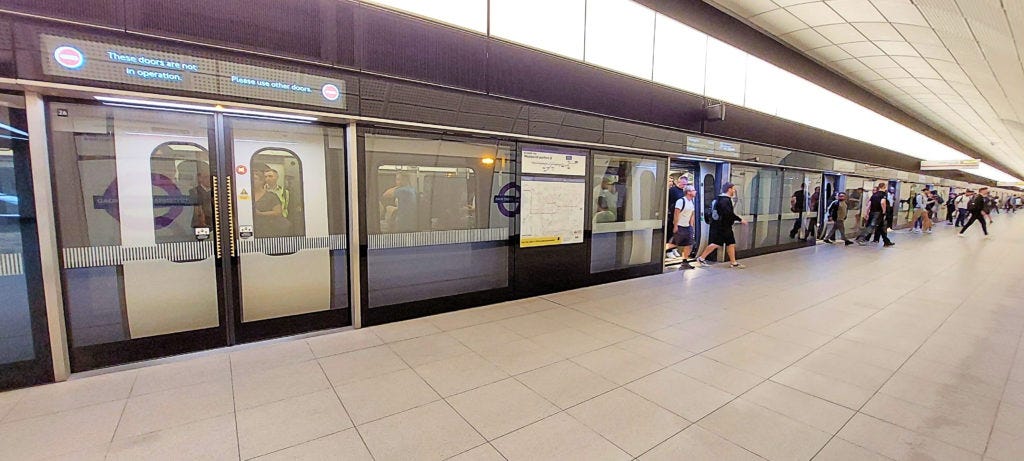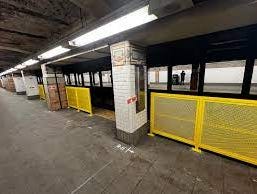What Happened to NYC's Platform Screen Doors?
Years of promises gave way to abandonment as flawed scope development and unrealistic expectations derailed the MTA’s program from the start.
After years of public pressure, the MTA announced a Platform Screen Door pilot program at the end of 2022 with the project to start in early 2024. Three years later, PSDs seem to be another project fallen by the wayside, so what happened?
First a little context. Platform Screen Doors (PSDs) are a staple in public transportation systems worldwide. Since their introduction in the mid-1980s, they have been widely adopted, particularly in Asia and much of Europe. New York's only platform protections are at Newark and JFK AirTrain people movers, not even subway stations. PSDs are full-height barriers installed along platform edges to protect passengers from oncoming trains. They synchronize with train doors, allowing safe boarding and exiting while preventing track access. (Though technically, PSDs refer to full-height barriers and platform screen gates to half-height ones intended for NYC, the terms will be used interchangeably here.)
Modern PSD installations offer additional benefits. For example, the Elizabeth Line in London features full-height PSDs that enhance climate control efficiency and significantly reduce platform litter—a notable advantage given that track fires from trash are a leading cause of NYC subway delays. As the MTA gradually modernizes, PSDs have shifted from a luxury to a necessary safety feature demanded by riders. Although the MTA announced a PSD pilot program for 2024, there has been no recent update on its progress.
Like many public projects in NYC, PSD implementation has a complicated history. In 2014, the MTA hired engineering firm STV to assess the feasibility of installing PSDs in the subway system. The 2020 report concluded that PSDs were impractical in nearly 73% of stations due to narrow platforms and limited pathways. While these constraints are valid, many stations remain suitable for PSD installation. Following a record surge in incidents of passengers being pushed onto tracks in 2022 public demand prompted the MTA to announce a PSD pilot program. Initially, the program was set to begin bidding in late 2023, with construction in 2024 funded by congestion pricing revenue. However, when Governor Hochul temporarily paused congestion pricing in summer 2024, PSD plans were sidelined. Even with congestion pricing reinstated, PSDs have been conspicuously absent from the MTA's revived projects.
Ultimately, after a two-year procurement process, the MTA scrapped the PSD program due to high costs. The process began in 2022 with a Request for Qualifications (RFQ) for eligible teams. Three teams—comprising experienced NYC general contractors, reputable national design firms, and proven international PSD manufacturers—were selected to bid. Despite their expertise, the submitted bids far exceeded the MTA's budget, leading to the program's quiet cancellation. The MTA has provided no updates to bidders regarding rescoping or rebidding.
I spent nearly two years leading one of the three prospective teams through the RFQ process, scope development, preliminary design, and cost estimating. From firsthand experience, three major factors contributed to the astronomical costs:
Decentralized Project Layout
The MTA selected three pilot stations: Sutphin Boulevard (E Train), 3rd Avenue (L Train), and Times Square-42nd Street (7 Train). These stations are 30 to 45 minutes apart, even under optimal traffic conditions. This geographic spread required duplicating management staff and MTA resources, inflating costs. By conservative estimates this can add 10 to 15% of additional administrative cost to the project. This decentralized approach, common in MTA projects, also complicated maintenance and increased associated expenses.Unrealistic Performance and Maintenance Standards
The contract demanded near-perfect PSD performance meeting, and in some cases exceeding, international standards. However, unlike other systems, NYC subways run 24/7 without scheduled outages. PSDs need regular maintenance, and NYC's aging system, filled with dust and debris, requires even more frequent upkeep. The MTA declined additional maintenance access, making recommended weekly preventive maintenance impossible. Instead, maintenance could only occur monthly or quarterly, leading to more costly repairs—much like skipping oil changes until an engine fails.The MTA also proposed a Manufacturer/Installer-Maintainer contract, a common structure where the installer oversees maintenance. However, the MTA's unique demand for a 30-minute response time to malfunctions required three full-time technical teams at each station, dramatically increasing costs. Grouping geographically closer stations could have reduced these costs while meeting performance standards.
Isolated Design and Outdated Technology Requirements
One of the objectives for a pilot program is identifying any issues and variations across the system. This consideration needs to be weighed with economies of scale earned from repetitive design and repeatable lessons learned. The selected stations may have varied too widely in design and operational needs. Sutphin Boulevard and Times Square have island platforms, requiring staircase relocations to accommodate PSDs. In contrast, 3rd Avenue features side platforms with obstructive support columns. These architectural differences eliminated design standardization and increased costs.
Operationally, each train line uses different signaling systems: the 7 Train uses CBTC by Thales, the L Train uses CBTC by Siemens, and the E Train relies on a legacy block system. PSDs must sync with train arrivals and door operations. However, due to the variation in MTA’s signaling systems, the agency chose to bypass integration entirely. This decision required PSDs to operate independently, resulting in custom, station-specific systems. This approach demanded extra sensors and controls, further increasing complexity and maintenance needs.
Additionally, NYC subway cars differ in size, door width, and spacing across lines. Each pilot station required custom-sized doors and panels, leading to one-off designs that inflated costs. Instead of adopting global PSD standards, the MTA insisted on three custom solutions with associated added cost.
To make PSDs feasible, the MTA must reduce design and implementation costs. The original STV report estimated a $7 billion system-wide rollout, averaging $14 million per station. Bids for the pilot program were over three times this estimate. Smarter contract structuring and streamlined design requirements can lower costs. Grouping consecutive stations with similar technical and operational profiles would improve economies of scale. The MTA should also adopt proven global technologies rather than force them into outdated systems and allow more frequent preventive maintenance to reduce long-term operational costs.
In the short term, the MTA can implement cost-effective safety measures. Installing simple metal railings along platform edges, already tested on the L Train, creates safer standing areas and reduces the risk of accidents. Though not a complete solution, partial barriers are better than none. While some stations cannot accommodate PSDs due to physical constraints, scalable, low-tech solutions like railings can still enhance safety. Early signs are encouraged with the MTA rolling out these platform barriers at a number of station already with more on the way. Some are still not satisfied with the pace. Just this week, Manhattan Assembly Member Tony Simone has announced a bill mandating the MTA implement them where ever possible as soon as possible. The logic is sound - the MTA continues to raise rates and charge congestion pricing, New Yorkers deserve to feel safe for that money.
PSDs are not gone from NYC's future. Riders expect a clean, reliable, and safe transit system, and PSDs are essential to fulfilling that promise. The MTA must reevaluate its contract terms, eliminate unnecessary complexities, design for scalability, and adopt proven technologies. PSDs will eventually arrive in NYC—the real question is when and at what cost.





Thanks for your insights into the MTA PSD program.
In my opinion, the MTA should be complimented on its relatively quick implementation of partial platform barriers, with existing staff and funding.
Judging from MTA reports and marks on platforms, more partial barriers are coming.